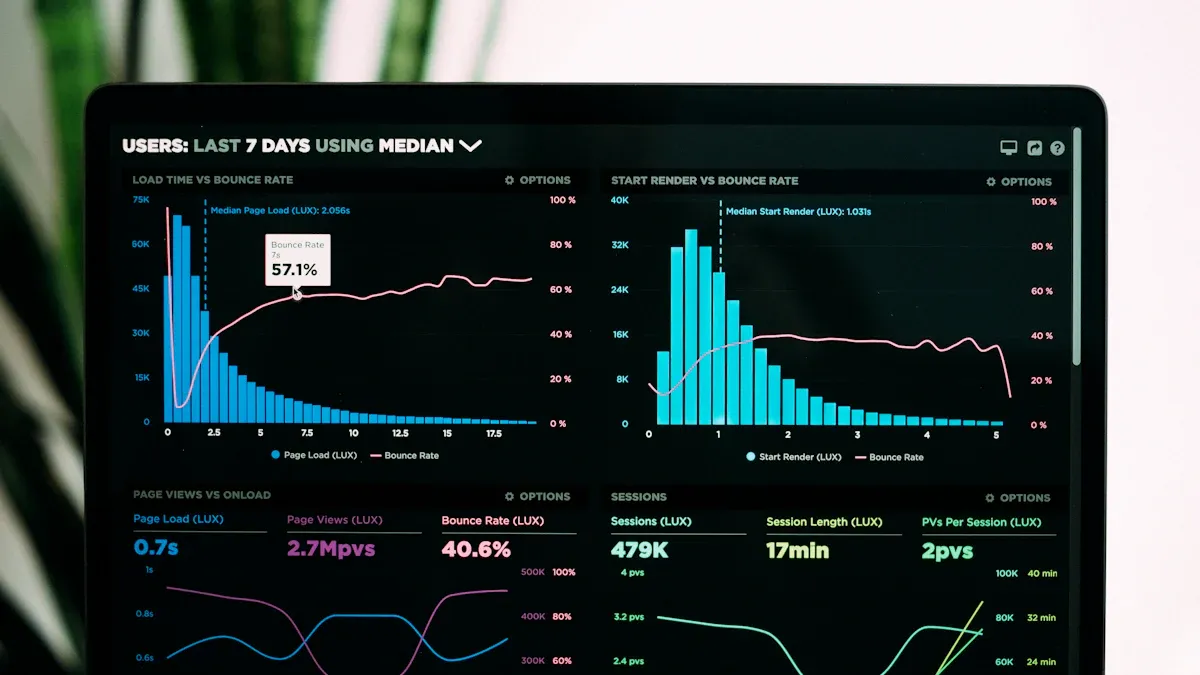Building a Unified Data Mart for S&OP Planning

A unified data mart serves as the backbone of successful Sales and Operations Planning (S&OP). It brings together data from multiple sources into a single, reliable platform, ensuring clean and integrated information for better decision-making. Automated integration reduces manual effort and errors, allowing you to focus on strategic tasks. With real-time data visibility, you gain continuous updates on reports and dashboards, empowering you to make timely and informed decisions. By offering a comprehensive view of operations, a unified data mart enhances collaboration across teams, streamlines processes, and boosts operational efficiency.
Key Takeaways
A unified data mart brings data together from many sources. This helps improve decisions and makes work smoother.
Seeing data in real-time helps make quick decisions. It lets companies react fast to changes and trends.
Sharing one platform helps teams work better together. It reduces confusion and keeps everyone focused on the same goals.
Using analytics tools turns raw data into useful ideas. This helps plan better and builds a habit of using data.
Testing and checking often keep the data mart working well. It adjusts to new business needs and keeps data accurate.
Understanding Unified Data Mart
Definition and Purpose
A unified data mart is a specialized subset of a data warehouse designed to meet specific business needs. It organizes data by subject area, making it easier for you to access and analyze relevant information. Unlike a general data warehouse, a data mart focuses on targeted insights, helping you make faster and more informed decisions.
Tip: Think of a unified data mart as a streamlined version of a data warehouse, tailored to specific departments or functions.
Across industries, companies use unified data marts to improve operations. For example:
Sector | Example Company | Use Case Description |
|---|---|---|
B2C | Utilizes a data warehouse to manage petabytes of data for efficient user experience and marketing strategies. | |
Financial | J.P. Morgan | Launched a Securities Services Data Mesh for consolidating investment data, enhancing compliance and risk assessments. |
Retail | Walmart | Employs ETL tools for real-time analytics to optimize inventory management and customer behavior analysis. |
Banking | Various Banks | Leverages data warehouses for credit risk assessments and fraud detection, improving decision-making processes. |
Government | Various Agencies | Integrates data from multiple departments to enhance service delivery and policy-making through data-driven insights. |
Healthcare | UC Health | Uses an Enterprise Data Warehouse for operational improvement and quality patient care through comprehensive data analysis. |
Key Components
Building a unified data mart requires several essential components. These elements ensure that your data mart functions efficiently and delivers accurate insights:
Data Sources: Collect data from various internal systems, such as ERP, CRM, and external sources.
ETL Processes: Extract, transform, and load (ETL) data to ensure consistency and usability.
Data Storage Models: Use schemas like star or snowflake to organize data for easy access.
Analytics Tools: Implement tools for reporting and visualization to help you interpret data effectively.
Note: Dependent data marts rely on enterprise data warehouses, while independent data marts are built for specific departmental needs.
Differences Between Data Mart and Data Warehouse
Understanding the differences between a data mart and a data warehouse helps you choose the right solution for your organization. While both store and manage data, their scope and functionality differ significantly:
Feature | Data Warehouse | Data Mart |
|---|---|---|
Data Structure | Stores detailed, granular data from multiple sources. | Focuses on specific subject areas or business functions. |
Performance | Handles large volumes of data and complex queries. | Provides faster query performance for targeted analysis. |
Focus and Purpose | Centralizes comprehensive data for analysis across the organization. | Offers a tailored approach to data management. |
Cost and Setup Time | Resource-intensive with significant up-front investment. | More cost-effective and faster to implement. |
Flexibility | Flexible regarding scalability and expansion. | Customizable and agile for departmental needs. |
Data Granularity | Stores detailed transaction-level data. | Can focus on aggregated or summarized data. |
Scope of Analysis | Supports complex, enterprise-wide analysis. | Facilitates targeted analysis within specific areas. |
Data Governance | Adheres to centralized data governance policies. | Varying levels of governance depending on departmental needs. |
Integration | Integrates data from various internal and external sources. | Limited integration capabilities, focusing on internal data. |
Security Controls | Implemented with robust security measures. | Varying levels of security controls based on needs. |
For example, a retail company might use a data warehouse to consolidate sales data from multiple regions, while a marketing team could use a data mart to analyze customer preferences and campaign performance.
Benefits of Unified Data Mart in S&OP Planning

Enhanced Forecasting and Demand Planning
A unified data mart empowers you to improve forecasting accuracy by consolidating historical and real-time data. With access to clean and organized data, you can apply both quantitative and qualitative forecasting methods. Quantitative forecasting uses historical data to predict future trends, while qualitative forecasting helps when historical data is unavailable.
Some common forecasting techniques include:
Moving Average
Exponential Smoothing
Regression Analysis
Econometric Models
Advanced methods like machine learning (ML) algorithms further enhance demand planning. For example:
Forecasting Method | Description | Effectiveness |
|---|---|---|
Machine Learning | Utilizes algorithms to enhance demand forecasting accuracy | Outperforms traditional methods |
ARIMA/ARIMAX | Common predictive models for demand forecasting | Systematic and reliable |
ANN/SVM/Regression Trees | Advanced ML algorithms that handle complex correlations | Superior to traditional methods |
By leveraging these tools, you can anticipate demand fluctuations and align resources accordingly. This proactive approach minimizes stockouts and overproduction, ensuring smoother operations.
Streamlined Operations and Resource Optimization
A unified data mart simplifies operations by centralizing data from various sources. This integration eliminates the need for manual data consolidation, saving you time and reducing errors. With a single source of truth, you can identify inefficiencies and optimize resource allocation.
For instance, real-time analytics allow you to monitor inventory levels and production schedules. This visibility helps you adjust operations to meet demand without overextending resources. Additionally, automated reporting tools provide actionable insights, enabling you to make quick adjustments to your supply chain.
Tip: Use dashboards to track key performance indicators (KPIs) like lead times, inventory turnover, and production efficiency.
Improved Collaboration Across Departments
Unified data marts foster collaboration by providing a shared platform for all departments. When everyone accesses the same data, it reduces miscommunication and ensures alignment on goals.
Empirical evidence highlights several ways data marts enhance collaboration:
Description | |
|---|---|
Modified analysis programs | Self-contained packages for diagnostic queries facilitate partner review. |
Data quality checks classification | Required checks must be fixed; investigative checks are explained. |
Summary of data quality exceptions | Summarized at the beginning of reports for easier review. |
Data management tools | Use of REDCap for streamlined data entry and analysis. |
Implementation Guidance | Addresses variability in data mapping across partners. |
Network-wide discussion forums | Facilitates sharing of best practices and common issues among partners. |
By streamlining communication and data sharing, you can break down silos and encourage teamwork. This collaboration leads to better decision-making and more cohesive S&OP planning.
Real-Time Insights for Proactive Decision-Making
Real-time insights give you the ability to make proactive decisions that drive better outcomes. A unified data mart consolidates data from multiple sources, enabling you to access up-to-date information instantly. This capability allows you to respond quickly to changes, identify trends, and address potential issues before they escalate.
For example, industries like healthcare, finance, telecommunications, and retail have successfully leveraged real-time data for proactive decision-making. The table below highlights some real-world examples:
Industry | Real-world Example | Benefits of Proactive Decision-Making |
|---|---|---|
Healthcare | Kaiser Permanente | - Reduced hospital stays by identifying at-risk patients earlier |
Financial Services | JPMorgan Chase | - Real-time fraud detection |
Telecommunications | Verizon | - Optimized network performance in real-time |
Retail | Target Corporation | - Successful personalized marketing campaigns |
These examples demonstrate how real-time insights can transform operations. For instance, Kaiser Permanente uses HealthConnect to monitor patient data and reduce hospital stays. Similarly, JPMorgan Chase employs real-time analytics to detect fraud and manage risks effectively. Verizon optimizes its network performance by analyzing data continuously, while Target Corporation enhances customer experiences through personalized marketing and efficient inventory management.
By using a unified data mart, you can achieve similar benefits. Real-time insights help you anticipate customer needs, streamline operations, and improve resource allocation. This proactive approach ensures that your organization stays ahead of challenges and seizes opportunities as they arise.
Tip: Use dashboards and visualization tools to monitor real-time data. These tools make it easier to identify patterns and take immediate action.
Steps to Build a Unified Data Mart

Identifying Data Sources and Requirements
The first step in building a unified data mart involves identifying the data sources and understanding your organization's requirements. Start by listing all the systems that generate or store data, such as ERP, CRM, and supply chain management tools. External sources, like market trends or customer feedback, should also be considered.
Once you identify the sources, define the specific requirements for your data mart. Ask questions like:
What business problems are you solving?
Which departments will use the data mart?
What types of reports or insights are needed?
A clear understanding of these requirements ensures that your data mart aligns with your business goals.
Tip: Use frameworks like DataLake (Bronze) for raw data storage, Data Warehouse (DWH) for staging and cleansing, and Data Marts (Gold) for domain-specific analytics. Tools like Apache Iceberg, PostgreSQL, and dbt (Data Build Tool) can streamline this process.
Data Collection and Normalization
After identifying your data sources, the next step is collecting and normalizing the data. Data collection involves extracting information from various systems and consolidating it into a central repository. This process ensures that all relevant data is available for analysis.
Normalization is critical for maintaining data consistency and integrity. It involves standardizing data formats, removing redundancies, and organizing information into structured formats. For example:
Standardizing date formats across systems.
Removing duplicate entries to avoid inaccuracies.
Organizing data into tables with clear relationships.
Benefits of normalization include improved system efficiency, reduced anomalies, and better decision-making. However, it also introduces challenges, such as slower query response rates and complexity in maintaining data connections when scaling up.
Note: Normalized data serves as a foundation for advanced technologies like AI and machine learning, enabling more accurate predictions and insights.
Integration and Consolidation of Data
Once the data is collected and normalized, the next step is integration and consolidation. This process combines data from multiple sources into a unified platform, ensuring seamless access and analysis.
Several techniques and procedures can help with integration and consolidation:
Technique/Procedure | Description |
|---|---|
ETL (Extract, Transform, Load) | Extracts data from sources, transforms it into a usable format, and loads it into the data mart. |
Data Virtualization | Provides a virtual view of data from multiple sources, enabling real-time access without creating a separate repository. |
Data Warehousing | Consolidates data into a central repository for efficient reporting and business intelligence. |
Middleware Data Integration | Acts as a bridge between systems, automating data transformation and validation for better communication. |
ETL is one of the most widely used methods for data consolidation. It ensures that data is clean, consistent, and ready for analysis. Data virtualization offers flexibility by allowing real-time access to data without the need for physical storage. Middleware integration simplifies communication between systems, making it easier to manage data flows.
Tip: Use tools like Trino for flexible querying and Power BI for reporting and visualization. These tools enhance the usability of your unified data mart and provide actionable insights.
Implementing Analytics and Reporting Tools
Analytics and reporting tools are essential for unlocking the full potential of your unified data mart. These tools transform raw data into actionable insights, enabling you to make informed decisions and drive strategic initiatives. By implementing the right tools, you can streamline analytics processes and foster a culture of data-driven collaboration.
To start, focus on identifying key business questions and performance indicators (KPIs). These metrics guide the selection of tools that align with your organization's goals. For example, tools like Microsoft Power BI and Tableau offer scalable dashboards and intuitive interfaces, making it easier to evaluate data and share insights across teams.
Here’s a comparison of popular analytics and reporting tools:
Tool Name | Description |
|---|---|
Esri ArcGIS Enterprise | Provides geospatial mapping and analysis to help reduce fraud, waste, and abuse in Medicare and Medicaid. |
AWS Services | Includes query services, data visualization tools, and data warehouses addressing various needs. |
SAP Business Objects | Supports ad hoc and OLAP reporting capabilities for the Center for Program Integrity. |
IBM Cognos Analytics | Provides reporting capabilities for multiple systems using Teradata data repository. |
Informatica PowerCenter | Integrates data warehouses and operational data stores with ETL capabilities. |
MicroStrategy | Generates interactive dashboards and automated report distribution. |
Microsoft Power BI | Offers a unified cloud-based service for data evaluation and sharing with scalable dashboards. |
SAS Enterprise Business Intelligence | Combines analytics and data management for better decision-making. |
Tableau | Provides intuitive BI tools for enhanced data discovery and understanding. |
When implementing these tools, involve stakeholders early in the process. Their input ensures the tools meet the needs of various departments and foster collaboration. Maintaining data quality standards is equally important. Reliable data builds trust and encourages open communication, turning your data mart into a valuable asset for decision-making.
Tip: Use interactive dashboards to visualize trends and patterns. These dashboards simplify complex data and make insights accessible to everyone in your organization.
Successful implementation of analytics tools has transformed organizations by providing immediate access to reliable data. This capability enhances decision-making at all levels and fosters a culture of collaboration. For example, data marts enable unified, reliable data from one source, empowering teams with rich insights and driving strategic initiatives.
Testing, Monitoring, and Continuous Improvement
Testing, monitoring, and continuous improvement ensure your unified data mart remains efficient and effective over time. These processes validate the accuracy of your data, optimize system performance, and adapt to evolving business needs.
Start by aligning technical metrics with business KPIs. This alignment ensures that performance indicators are understood in the context of their impact on operations. For example, tracking lead times or inventory turnover helps you measure the effectiveness of your data mart in supporting S&OP planning.
Proactive issue resolution is another critical aspect. Early identification and resolution of issues during the development cycle improve overall efficiency. Regular testing protocols, such as stress tests and data validation checks, help you identify potential bottlenecks and ensure system reliability.
Continuous improvement involves monitoring business lead indicators. These early warning signs help you anticipate and address potential issues before they escalate. For instance, if data processing times increase, it may signal the need for system optimization or additional resources.
Tip: Use automated monitoring tools to track system performance and generate alerts for anomalies. These tools save time and ensure timely responses to issues.
To maintain efficiency, establish a feedback loop with stakeholders. Regular reviews of system performance and user feedback provide valuable insights for improvement. This iterative approach ensures your data mart evolves to meet changing business requirements.
By implementing robust testing and monitoring protocols, you can validate the efficiency of your data mart and drive continuous improvement. These strategies not only enhance system reliability but also ensure your data mart remains a trusted resource for decision-making.
Overcoming Challenges in Unified Data Mart Implementation
Ensuring Data Quality and Accuracy
Maintaining high data quality is essential for the success of your unified data mart. Poor-quality data can lead to inaccurate insights and flawed decision-making. To ensure reliability, you need to focus on key data quality metrics. These metrics help you evaluate and improve the accuracy, consistency, and completeness of your data.
Metric | Description |
|---|---|
Accuracy | Ensures that data reflects the real-world values it represents. |
Completeness | Measures the extent to which all required data is available. |
Consistency | Evaluates whether data is uniform across different databases and systems. |
Timeliness | Ensures that data is up-to-date and available when needed. |
Validity | Checks that data conforms to the required formats and standards. |
Uniqueness | Ensures that each record is distinct and not duplicated within the dataset. |
To improve data quality, implement regular audits and validation checks. Use automated tools to identify inconsistencies and errors. Standardizing data formats and removing duplicates also enhances accuracy.
Tip: Establish clear data governance policies to maintain quality over time. These policies define roles, responsibilities, and procedures for managing data effectively.
Addressing Scalability and Flexibility
As your organization grows, your data mart must handle increasing volumes of data and adapt to changing business needs. Scalability ensures that your system can expand without compromising performance. Flexibility allows you to integrate new data sources and adjust to evolving requirements.
To achieve scalability, consider cloud-based solutions. These platforms offer on-demand resources, making it easier to scale up or down as needed. For flexibility, use modular architectures and open-source tools. These approaches simplify the integration of new technologies and data sources.
Note: Regularly monitor system performance to identify bottlenecks. Addressing these issues early prevents disruptions and ensures smooth operations.
Securing Stakeholder Buy-In
Gaining stakeholder support is crucial for the successful implementation of your unified data mart. Without buy-in, you may face resistance that delays or derails the project. To secure support, focus on demonstrating value and addressing concerns.
Strategy | Description |
|---|---|
Run a PoC with real data | Demonstrate immediate value with tangible results using a small dataset. |
Align with business goals & KPIs | Map the initiative to executive priorities and define success metrics. |
Involve stakeholders early & often | Create a sense of ownership by engaging key stakeholders in the process. |
Quantify cost savings & efficiency gains | Use numbers to drive decision-making, especially for finance teams. |
Present case studies & industry trends | Show that competitors are adopting similar solutions. |
Demonstrate low-risk, phased implementation | Propose a phased rollout to reduce fear of disruption. |
Address security, compliance & governance concerns | Explain how the solution meets compliance needs. |
Engage stakeholders through regular updates and collaborative workshops. Highlight how the data mart aligns with their goals and solves specific challenges. Sharing success stories from other organizations can also build confidence in the project.
Tip: Use a phased implementation approach to minimize risks. This strategy allows stakeholders to see results early, increasing their trust and support.
Managing Costs and Resources Effectively
Managing costs and resources effectively is crucial when implementing a unified data mart. A well-planned approach ensures that your investment delivers maximum value while staying within budget. By focusing on key financial strategies, you can optimize resource allocation and minimize unnecessary expenses.
Start by ensuring your data is clean, consistent, and relevant. High-quality data reduces the risk of errors and misinterpretations, providing a solid foundation for analysis and reporting. This step not only saves time but also prevents costly mistakes in decision-making.
A unified data mart acts as a centralized hub for streamlined data management. It allows you to import spreadsheets and connect to live data sources, making it cost-effective and efficient for finance teams. This setup enhances control over financial analysis and provides the adaptability needed to respond to changing business needs.
Tip: Use tools that support data extraction, transformation, and loading (ETL) processes. These tools ensure high-quality data, which leads to better decision-making and supports trend identification.
To optimize costs further, follow these steps:
Prioritize data that directly impacts your business goals.
Use scalable cloud-based solutions to avoid over-investing in infrastructure.
Regularly monitor system performance to identify inefficiencies.
Data marts are designed to provide actionable information quickly. They blend data from various sources to answer specific business questions. This focus on performance prevents slow queries, which can increase resource costs.
By managing costs effectively, you can allocate resources to areas that drive growth. A unified data mart not only reduces operational inefficiencies but also empowers you to make strategic decisions that benefit your organization in the long run.
Note: Regular audits and performance reviews help you stay on track and adapt to evolving requirements without overspending.
A unified data mart plays a vital role in transforming your S&OP planning. It streamlines operations, enhances collaboration, and enables proactive risk management. By consolidating data into a single platform, you eliminate inefficiencies and align your teams with shared goals. The table below highlights its key benefits:
Benefit | Description |
|---|---|
Eliminates waste and inefficiencies through data analysis, leading to lower costs and optimized supply chain. | |
Proactive Risk Management | Establishes early warning systems for potential risks, enabling proactive mitigation strategies. |
Improved Collaboration | Fosters collaboration across departments, enhancing decision-making and aligning with business goals. |
Enhanced Patient Outcomes | Ensures reliable drug availability and reduces the risk of counterfeit drugs, improving patient safety. |
To adopt a unified data mart effectively, consider these actionable steps:
Integrate data, people, and processes for seamless S&OP planning.
Address system integration challenges and harmonize master data.
Establish a single source of truth for KPIs, even if data isn't perfect.
Secure executive leadership support to drive adoption and success.
By taking these steps, you can unlock the full potential of your S&OP processes and position your organization for long-term success.
FAQ
What is the main purpose of a unified data mart?
A unified data mart helps you consolidate data from multiple sources into one platform. This makes it easier to analyze, share, and use data for decision-making. It improves efficiency, reduces errors, and supports better collaboration across departments.
How does a data mart differ from a data warehouse?
A data mart focuses on specific business areas, like sales or marketing. It provides faster access to targeted insights. A data warehouse, on the other hand, stores detailed data from across the organization for broader analysis.
What tools can you use to build a unified data mart?
You can use tools like Microsoft Power BI, Tableau, or Informatica PowerCenter. These tools help you collect, clean, and analyze data. They also provide dashboards and reports to visualize trends and patterns effectively.
How do you ensure data quality in a unified data mart?
You can ensure data quality by performing regular audits, removing duplicates, and standardizing formats. Automated tools can help you identify errors and inconsistencies. Clear data governance policies also play a key role in maintaining accuracy and consistency.
Why is stakeholder buy-in important for implementation?
Stakeholder buy-in ensures everyone supports the project. It reduces resistance and speeds up adoption. Engaging stakeholders early, showing clear benefits, and addressing concerns help you gain their trust and commitment.
See Also
Creating A Data-Centric Framework For Retail Product Introductions
SQL And BI Techniques To Analyze User Behavior Easily
Retail Demand Forecasting Techniques For Weekly Planning
The Pitfalls Of Fixed Delivery Plans In Same-Day Retail
Transforming Data Challenges Into Opportunities: Atlas And Singdata

